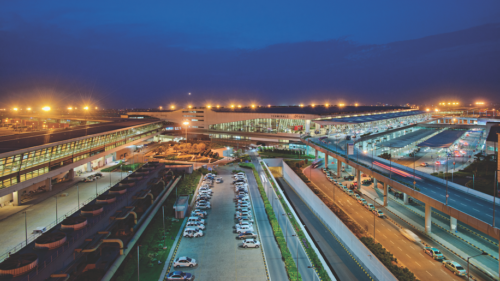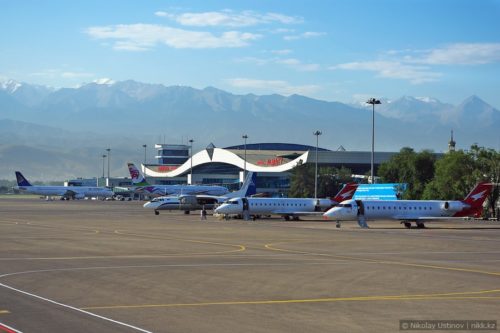Santiago Airport is operated under a 20-year concession, won in February 2015, by Nuevo Pudahuel consortium, gathering Groupe ADP (45%), VINCI Airports (40%) and Astaldi Concessioni (15%).
The new terminal creates the most modern international hub in South America, with an increased capacity of 38 million passengers per year.
The investment of US$990 million (€860 million) in this terminal is a long-term commitment to Chile’s economic growth, through the development of air connectivity.
Sebastián Piñera, President of the Republic of Chile and Xavier Lortat-Jacob, General Manager of Nuevo Pudahuel consortium inaugurated, on February 26th, Santiago airport’s new international terminal, that started serving its first passengers on February 28th.
The commissioning of this new 248,400 sq.m terminal turns Santiago airport into an international hub, the most modern in South America. With the extension of the existing terminal, now reassigned to domestic traffic, the airport’s capacity more than doubles, going from 16 to 38 million passengers a year. The work was carried out in less five years by VINCI Construction Grands Projets and Astaldi.
This operation represents an investment of US$990 million (€860 million), the largest one in the history of infrastructure concessions in Chile. It reflects the long-term commitment of the concessionaires with the Chile’s economy, through the development of air connectivity. The new terminal will make it possible to recover and sustain the traffic growth that began since the starts of the concession in 2015. The Santiago airport received 24.6 million passengers in 2019 thanks to the opening of 20 new international destinations and the arrival of six new airlines to four years.
Passenger experience will be improved. With this new terminal, waiting times will be reduced considerably because of 96 automatic check-in kiosks, 64 bag drop counters, 40% more immigration counters for borders controls, and a new baggage handling system. The terminal also includes ew commercial, restaurants and services areas, such as a nursery room and an exhibition hall.
Santiago airport is immersed in an active process of environmental transition backed by Groupe ADP’s Environment plan and VINCI Airports’ AirPact policy. They have allowed the airport to be one of the first in South America to join Level 2 of the ACA (Airport Carbon Accreditation) delivered by ACI (Airports Council International). 10,336 airport LED lights have been settled, reducing lighting energy consumption by 70%. Emissions from land transport are also reduced thanks to six new electric buses that entered service last July. More than seven hectares have been reforested on the airport ground and more than 600 trees have been donated to the municipality of Pudahuel.
This dynamic will be further strengthened in coming months. With the commissioning of a photovoltaic plant with a capacity of 826KW, set on the roof of the existing terminal. Finally, the global objective is to reduce the airport’s carbon footprint by 40% in 2030 and achieve net zero emission by 2050.
Xavier Lortat-Jacob, General Manager of Nuevo Pudahuel consortium, said: "This works summarizes the combined experience anc knowledge of Groupe ADP, VINCI Airports and Astaldi Concessioni in the operation and construction around the world. We are providint Chile with a new gaterway to the country that meets the highest international standards, further enhancing the attractiveness of Santiago Airport, helping to strengthen Chile's connectivity with the wolrd and fulfilling its potential as a business, tourism and innovation center in Latin America."
Main features of the new terminal:
The new terminal creates the most modern international hub in South America, with an increased capacity of 38 million passengers per year.
The investment of US$990 million (€860 million) in this terminal is a long-term commitment to Chile’s economic growth, through the development of air connectivity.
Sebastián Piñera, President of the Republic of Chile and Xavier Lortat-Jacob, General Manager of Nuevo Pudahuel consortium inaugurated, on February 26th, Santiago airport’s new international terminal, that started serving its first passengers on February 28th.
The commissioning of this new 248,400 sq.m terminal turns Santiago airport into an international hub, the most modern in South America. With the extension of the existing terminal, now reassigned to domestic traffic, the airport’s capacity more than doubles, going from 16 to 38 million passengers a year. The work was carried out in less five years by VINCI Construction Grands Projets and Astaldi.
This operation represents an investment of US$990 million (€860 million), the largest one in the history of infrastructure concessions in Chile. It reflects the long-term commitment of the concessionaires with the Chile’s economy, through the development of air connectivity. The new terminal will make it possible to recover and sustain the traffic growth that began since the starts of the concession in 2015. The Santiago airport received 24.6 million passengers in 2019 thanks to the opening of 20 new international destinations and the arrival of six new airlines to four years.
Passenger experience will be improved. With this new terminal, waiting times will be reduced considerably because of 96 automatic check-in kiosks, 64 bag drop counters, 40% more immigration counters for borders controls, and a new baggage handling system. The terminal also includes ew commercial, restaurants and services areas, such as a nursery room and an exhibition hall.
Santiago airport is immersed in an active process of environmental transition backed by Groupe ADP’s Environment plan and VINCI Airports’ AirPact policy. They have allowed the airport to be one of the first in South America to join Level 2 of the ACA (Airport Carbon Accreditation) delivered by ACI (Airports Council International). 10,336 airport LED lights have been settled, reducing lighting energy consumption by 70%. Emissions from land transport are also reduced thanks to six new electric buses that entered service last July. More than seven hectares have been reforested on the airport ground and more than 600 trees have been donated to the municipality of Pudahuel.
This dynamic will be further strengthened in coming months. With the commissioning of a photovoltaic plant with a capacity of 826KW, set on the roof of the existing terminal. Finally, the global objective is to reduce the airport’s carbon footprint by 40% in 2030 and achieve net zero emission by 2050.
Xavier Lortat-Jacob, General Manager of Nuevo Pudahuel consortium, said: "This works summarizes the combined experience anc knowledge of Groupe ADP, VINCI Airports and Astaldi Concessioni in the operation and construction around the world. We are providint Chile with a new gaterway to the country that meets the highest international standards, further enhancing the attractiveness of Santiago Airport, helping to strengthen Chile's connectivity with the wolrd and fulfilling its potential as a business, tourism and innovation center in Latin America."
Main features of the new terminal:
- Total investment: ~ US$990 million (~€860 million).
- Total surface area of work executed: 454,700 sq.m of which: 248,400 sq.m for the international terminal; 130,400 sq.m of car parks and boulevards; 15,700 sq.m for extension of the existing terminal (Pier A) and 16,740 sq.m of interurban bus station.
- Airport capacity increased from 16 to 38 million passengers per year.
- Gateways increased from 18 to 67.
- Boarding gates increased 31 to 76.
- 5 year of works and 3,800 jobs created at the peak of works.
- 40% reduction in carbon footprint by 2030.









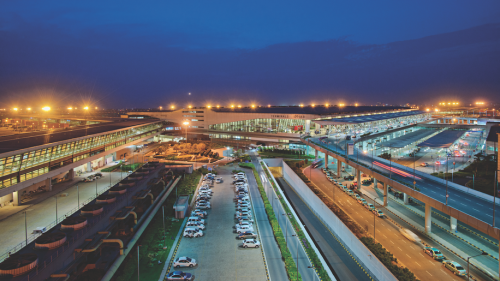
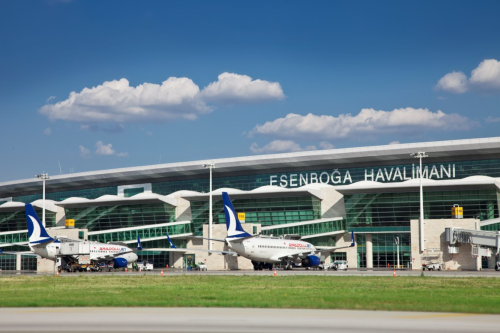


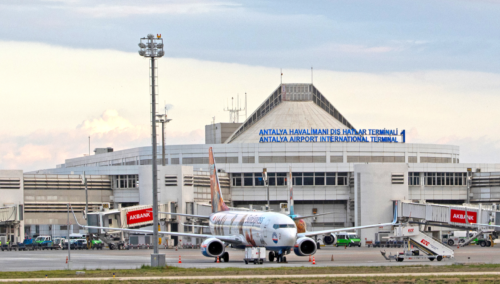

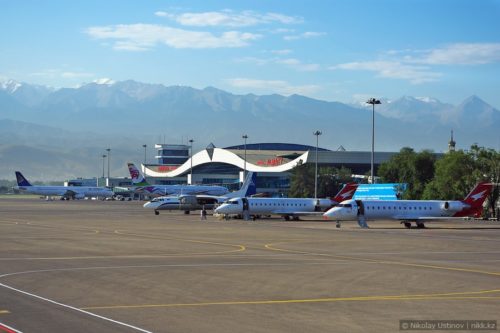

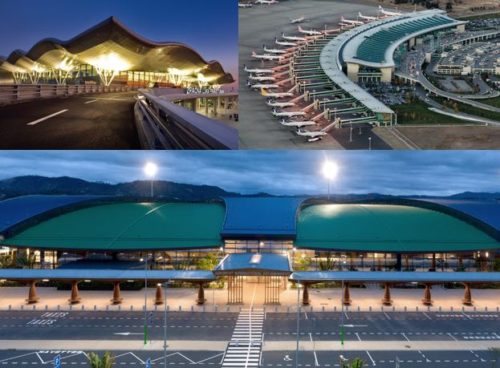 and commit to building a sustainable and responsible future">
and commit to building a sustainable and responsible future">
